Assessing Systems Thinking's Role in Sustainability Challenges: Essay
VerifiedAdded on 2020/02/24
|10
|2795
|343
Essay
AI Summary
This essay delves into the concept of sustainability and the critical role of systems thinking in addressing complex global and local challenges, particularly focusing on the wicked issue of domestic violence. It defines sustainability as the ability of biological systems to endure and emphasizes the interconnected elements of ecological, economic, political, and cultural aspects. The essay argues that traditional problem-solving methods are insufficient for tackling "wicked issues" and highlights the need for a systems thinking approach, which involves understanding the interconnections within a system rather than examining isolated components. The analysis explores how systems thinking can diagnose and resolve sustainability problems, using domestic violence as a case study. The essay examines the causes and effects of domestic violence, its impact on families, and the need for a systemic approach to address this issue effectively. The conclusion emphasizes the importance of policy changes and collaborative efforts to achieve sustainable solutions.
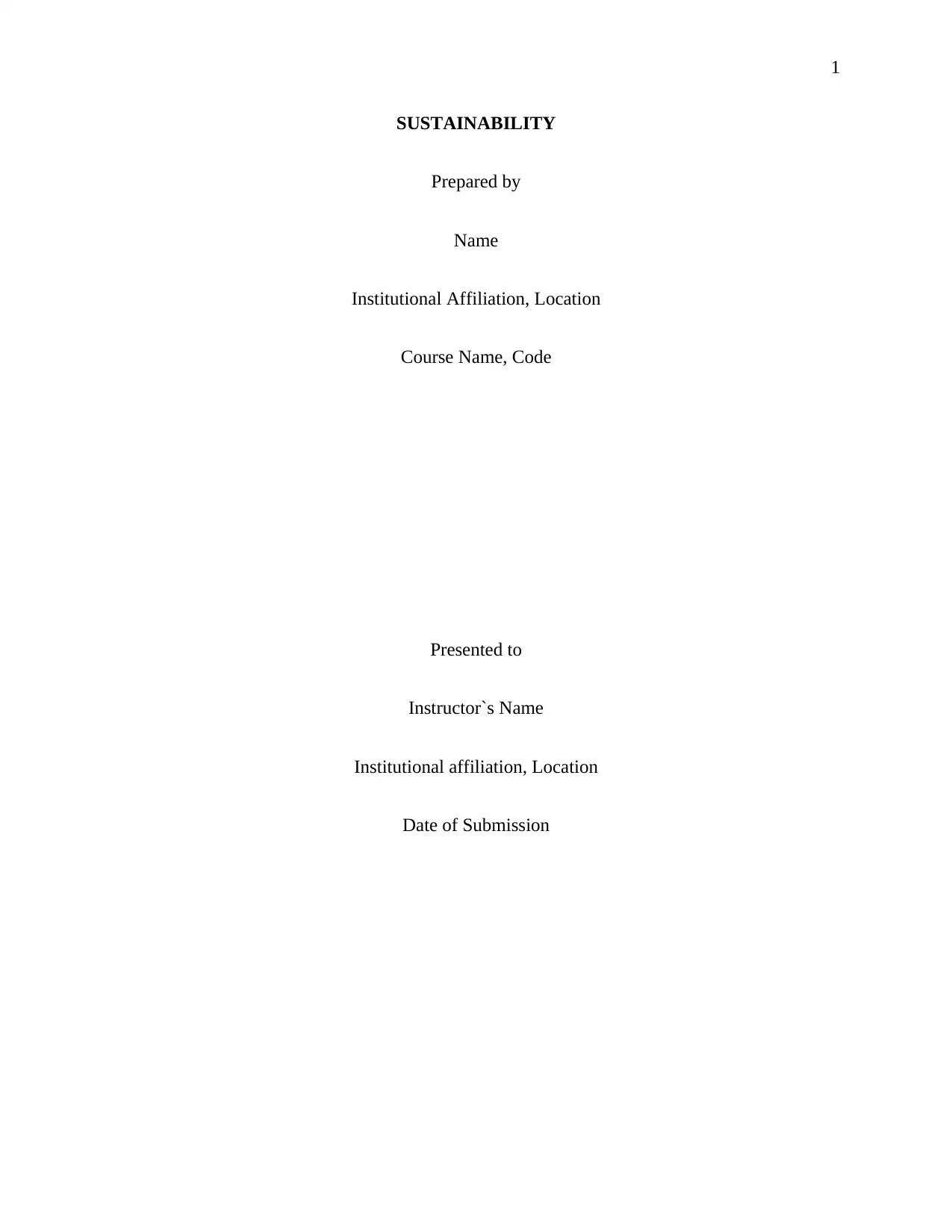
1
SUSTAINABILITY
Prepared by
Name
Institutional Affiliation, Location
Course Name, Code
Presented to
Instructor`s Name
Institutional affiliation, Location
Date of Submission
SUSTAINABILITY
Prepared by
Name
Institutional Affiliation, Location
Course Name, Code
Presented to
Instructor`s Name
Institutional affiliation, Location
Date of Submission
Paraphrase This Document
Need a fresh take? Get an instant paraphrase of this document with our AI Paraphraser
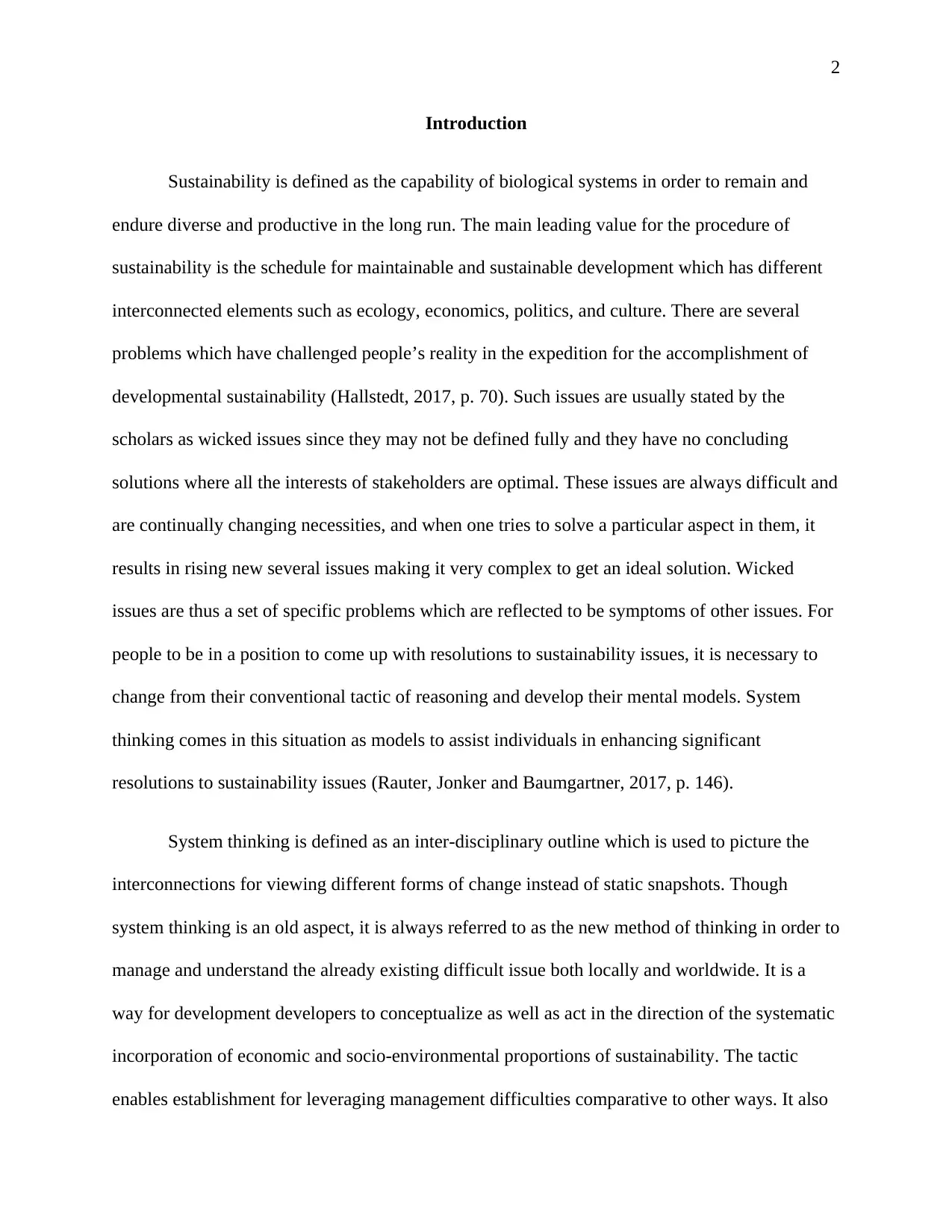
2
Introduction
Sustainability is defined as the capability of biological systems in order to remain and
endure diverse and productive in the long run. The main leading value for the procedure of
sustainability is the schedule for maintainable and sustainable development which has different
interconnected elements such as ecology, economics, politics, and culture. There are several
problems which have challenged people’s reality in the expedition for the accomplishment of
developmental sustainability (Hallstedt, 2017, p. 70). Such issues are usually stated by the
scholars as wicked issues since they may not be defined fully and they have no concluding
solutions where all the interests of stakeholders are optimal. These issues are always difficult and
are continually changing necessities, and when one tries to solve a particular aspect in them, it
results in rising new several issues making it very complex to get an ideal solution. Wicked
issues are thus a set of specific problems which are reflected to be symptoms of other issues. For
people to be in a position to come up with resolutions to sustainability issues, it is necessary to
change from their conventional tactic of reasoning and develop their mental models. System
thinking comes in this situation as models to assist individuals in enhancing significant
resolutions to sustainability issues (Rauter, Jonker and Baumgartner, 2017, p. 146).
System thinking is defined as an inter-disciplinary outline which is used to picture the
interconnections for viewing different forms of change instead of static snapshots. Though
system thinking is an old aspect, it is always referred to as the new method of thinking in order to
manage and understand the already existing difficult issue both locally and worldwide. It is a
way for development developers to conceptualize as well as act in the direction of the systematic
incorporation of economic and socio-environmental proportions of sustainability. The tactic
enables establishment for leveraging management difficulties comparative to other ways. It also
Introduction
Sustainability is defined as the capability of biological systems in order to remain and
endure diverse and productive in the long run. The main leading value for the procedure of
sustainability is the schedule for maintainable and sustainable development which has different
interconnected elements such as ecology, economics, politics, and culture. There are several
problems which have challenged people’s reality in the expedition for the accomplishment of
developmental sustainability (Hallstedt, 2017, p. 70). Such issues are usually stated by the
scholars as wicked issues since they may not be defined fully and they have no concluding
solutions where all the interests of stakeholders are optimal. These issues are always difficult and
are continually changing necessities, and when one tries to solve a particular aspect in them, it
results in rising new several issues making it very complex to get an ideal solution. Wicked
issues are thus a set of specific problems which are reflected to be symptoms of other issues. For
people to be in a position to come up with resolutions to sustainability issues, it is necessary to
change from their conventional tactic of reasoning and develop their mental models. System
thinking comes in this situation as models to assist individuals in enhancing significant
resolutions to sustainability issues (Rauter, Jonker and Baumgartner, 2017, p. 146).
System thinking is defined as an inter-disciplinary outline which is used to picture the
interconnections for viewing different forms of change instead of static snapshots. Though
system thinking is an old aspect, it is always referred to as the new method of thinking in order to
manage and understand the already existing difficult issue both locally and worldwide. It is a
way for development developers to conceptualize as well as act in the direction of the systematic
incorporation of economic and socio-environmental proportions of sustainability. The tactic
enables establishment for leveraging management difficulties comparative to other ways. It also
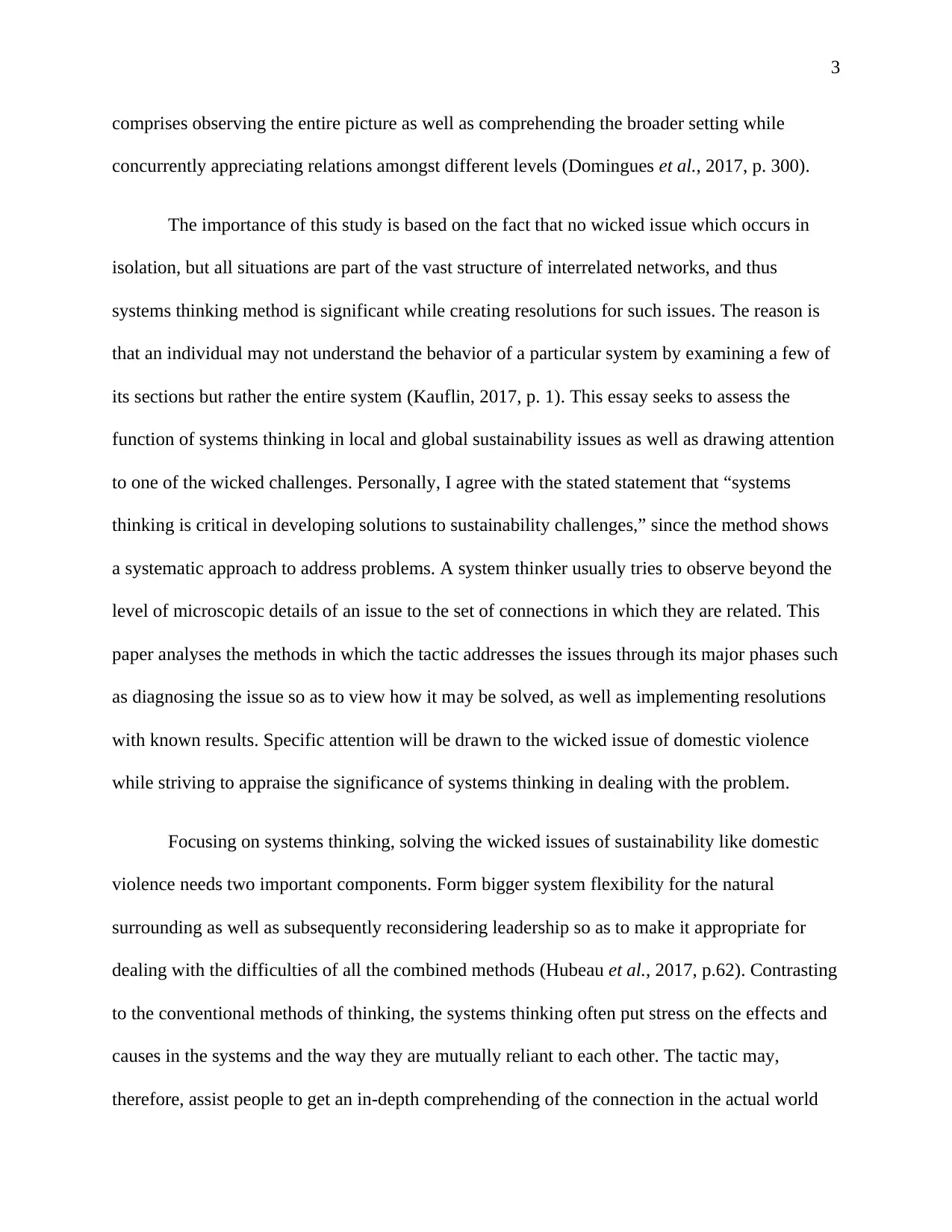
3
comprises observing the entire picture as well as comprehending the broader setting while
concurrently appreciating relations amongst different levels (Domingues et al., 2017, p. 300).
The importance of this study is based on the fact that no wicked issue which occurs in
isolation, but all situations are part of the vast structure of interrelated networks, and thus
systems thinking method is significant while creating resolutions for such issues. The reason is
that an individual may not understand the behavior of a particular system by examining a few of
its sections but rather the entire system (Kauflin, 2017, p. 1). This essay seeks to assess the
function of systems thinking in local and global sustainability issues as well as drawing attention
to one of the wicked challenges. Personally, I agree with the stated statement that “systems
thinking is critical in developing solutions to sustainability challenges,” since the method shows
a systematic approach to address problems. A system thinker usually tries to observe beyond the
level of microscopic details of an issue to the set of connections in which they are related. This
paper analyses the methods in which the tactic addresses the issues through its major phases such
as diagnosing the issue so as to view how it may be solved, as well as implementing resolutions
with known results. Specific attention will be drawn to the wicked issue of domestic violence
while striving to appraise the significance of systems thinking in dealing with the problem.
Focusing on systems thinking, solving the wicked issues of sustainability like domestic
violence needs two important components. Form bigger system flexibility for the natural
surrounding as well as subsequently reconsidering leadership so as to make it appropriate for
dealing with the difficulties of all the combined methods (Hubeau et al., 2017, p.62). Contrasting
to the conventional methods of thinking, the systems thinking often put stress on the effects and
causes in the systems and the way they are mutually reliant to each other. The tactic may,
therefore, assist people to get an in-depth comprehending of the connection in the actual world
comprises observing the entire picture as well as comprehending the broader setting while
concurrently appreciating relations amongst different levels (Domingues et al., 2017, p. 300).
The importance of this study is based on the fact that no wicked issue which occurs in
isolation, but all situations are part of the vast structure of interrelated networks, and thus
systems thinking method is significant while creating resolutions for such issues. The reason is
that an individual may not understand the behavior of a particular system by examining a few of
its sections but rather the entire system (Kauflin, 2017, p. 1). This essay seeks to assess the
function of systems thinking in local and global sustainability issues as well as drawing attention
to one of the wicked challenges. Personally, I agree with the stated statement that “systems
thinking is critical in developing solutions to sustainability challenges,” since the method shows
a systematic approach to address problems. A system thinker usually tries to observe beyond the
level of microscopic details of an issue to the set of connections in which they are related. This
paper analyses the methods in which the tactic addresses the issues through its major phases such
as diagnosing the issue so as to view how it may be solved, as well as implementing resolutions
with known results. Specific attention will be drawn to the wicked issue of domestic violence
while striving to appraise the significance of systems thinking in dealing with the problem.
Focusing on systems thinking, solving the wicked issues of sustainability like domestic
violence needs two important components. Form bigger system flexibility for the natural
surrounding as well as subsequently reconsidering leadership so as to make it appropriate for
dealing with the difficulties of all the combined methods (Hubeau et al., 2017, p.62). Contrasting
to the conventional methods of thinking, the systems thinking often put stress on the effects and
causes in the systems and the way they are mutually reliant to each other. The tactic may,
therefore, assist people to get an in-depth comprehending of the connection in the actual world
⊘ This is a preview!⊘
Do you want full access?
Subscribe today to unlock all pages.

Trusted by 1+ million students worldwide
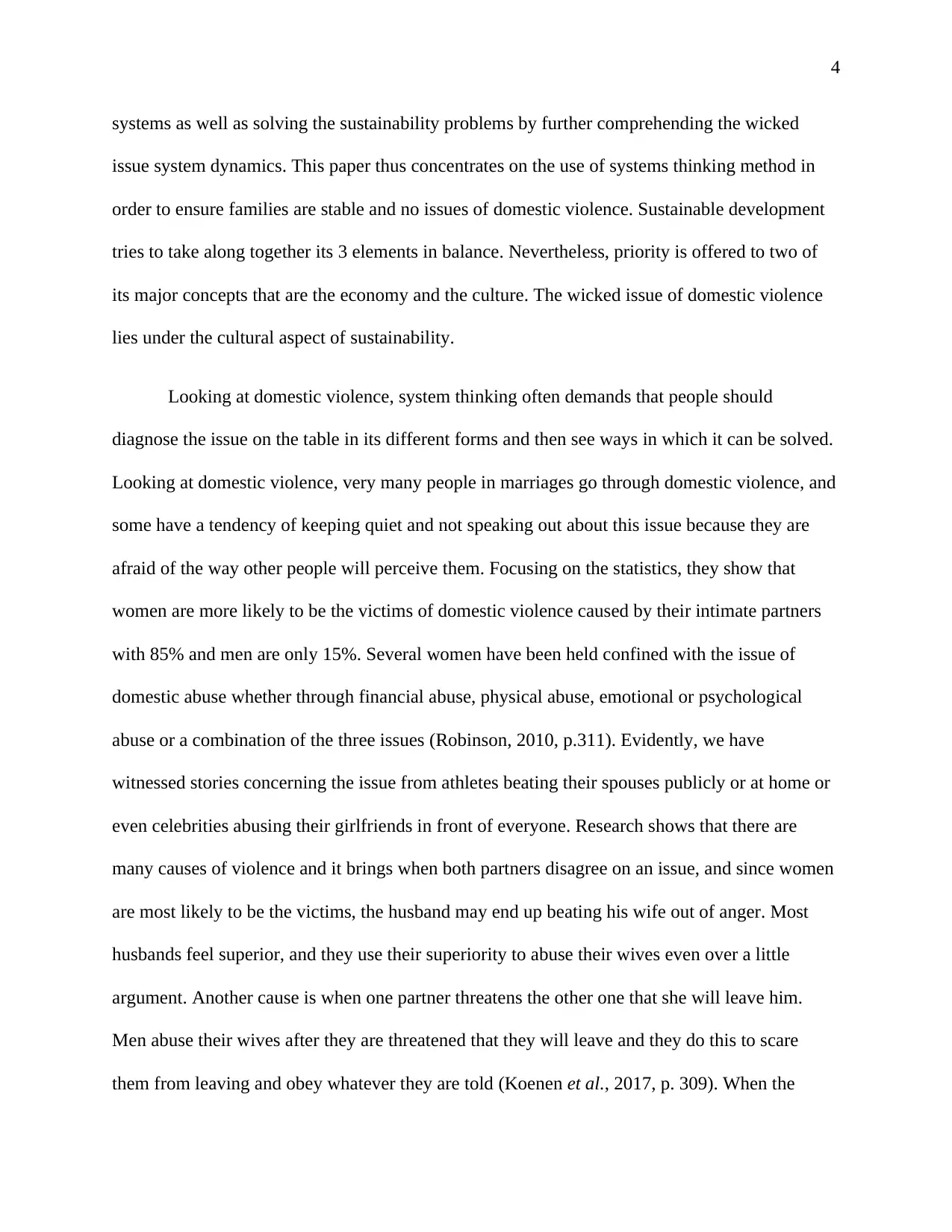
4
systems as well as solving the sustainability problems by further comprehending the wicked
issue system dynamics. This paper thus concentrates on the use of systems thinking method in
order to ensure families are stable and no issues of domestic violence. Sustainable development
tries to take along together its 3 elements in balance. Nevertheless, priority is offered to two of
its major concepts that are the economy and the culture. The wicked issue of domestic violence
lies under the cultural aspect of sustainability.
Looking at domestic violence, system thinking often demands that people should
diagnose the issue on the table in its different forms and then see ways in which it can be solved.
Looking at domestic violence, very many people in marriages go through domestic violence, and
some have a tendency of keeping quiet and not speaking out about this issue because they are
afraid of the way other people will perceive them. Focusing on the statistics, they show that
women are more likely to be the victims of domestic violence caused by their intimate partners
with 85% and men are only 15%. Several women have been held confined with the issue of
domestic abuse whether through financial abuse, physical abuse, emotional or psychological
abuse or a combination of the three issues (Robinson, 2010, p.311). Evidently, we have
witnessed stories concerning the issue from athletes beating their spouses publicly or at home or
even celebrities abusing their girlfriends in front of everyone. Research shows that there are
many causes of violence and it brings when both partners disagree on an issue, and since women
are most likely to be the victims, the husband may end up beating his wife out of anger. Most
husbands feel superior, and they use their superiority to abuse their wives even over a little
argument. Another cause is when one partner threatens the other one that she will leave him.
Men abuse their wives after they are threatened that they will leave and they do this to scare
them from leaving and obey whatever they are told (Koenen et al., 2017, p. 309). When the
systems as well as solving the sustainability problems by further comprehending the wicked
issue system dynamics. This paper thus concentrates on the use of systems thinking method in
order to ensure families are stable and no issues of domestic violence. Sustainable development
tries to take along together its 3 elements in balance. Nevertheless, priority is offered to two of
its major concepts that are the economy and the culture. The wicked issue of domestic violence
lies under the cultural aspect of sustainability.
Looking at domestic violence, system thinking often demands that people should
diagnose the issue on the table in its different forms and then see ways in which it can be solved.
Looking at domestic violence, very many people in marriages go through domestic violence, and
some have a tendency of keeping quiet and not speaking out about this issue because they are
afraid of the way other people will perceive them. Focusing on the statistics, they show that
women are more likely to be the victims of domestic violence caused by their intimate partners
with 85% and men are only 15%. Several women have been held confined with the issue of
domestic abuse whether through financial abuse, physical abuse, emotional or psychological
abuse or a combination of the three issues (Robinson, 2010, p.311). Evidently, we have
witnessed stories concerning the issue from athletes beating their spouses publicly or at home or
even celebrities abusing their girlfriends in front of everyone. Research shows that there are
many causes of violence and it brings when both partners disagree on an issue, and since women
are most likely to be the victims, the husband may end up beating his wife out of anger. Most
husbands feel superior, and they use their superiority to abuse their wives even over a little
argument. Another cause is when one partner threatens the other one that she will leave him.
Men abuse their wives after they are threatened that they will leave and they do this to scare
them from leaving and obey whatever they are told (Koenen et al., 2017, p. 309). When the
Paraphrase This Document
Need a fresh take? Get an instant paraphrase of this document with our AI Paraphraser
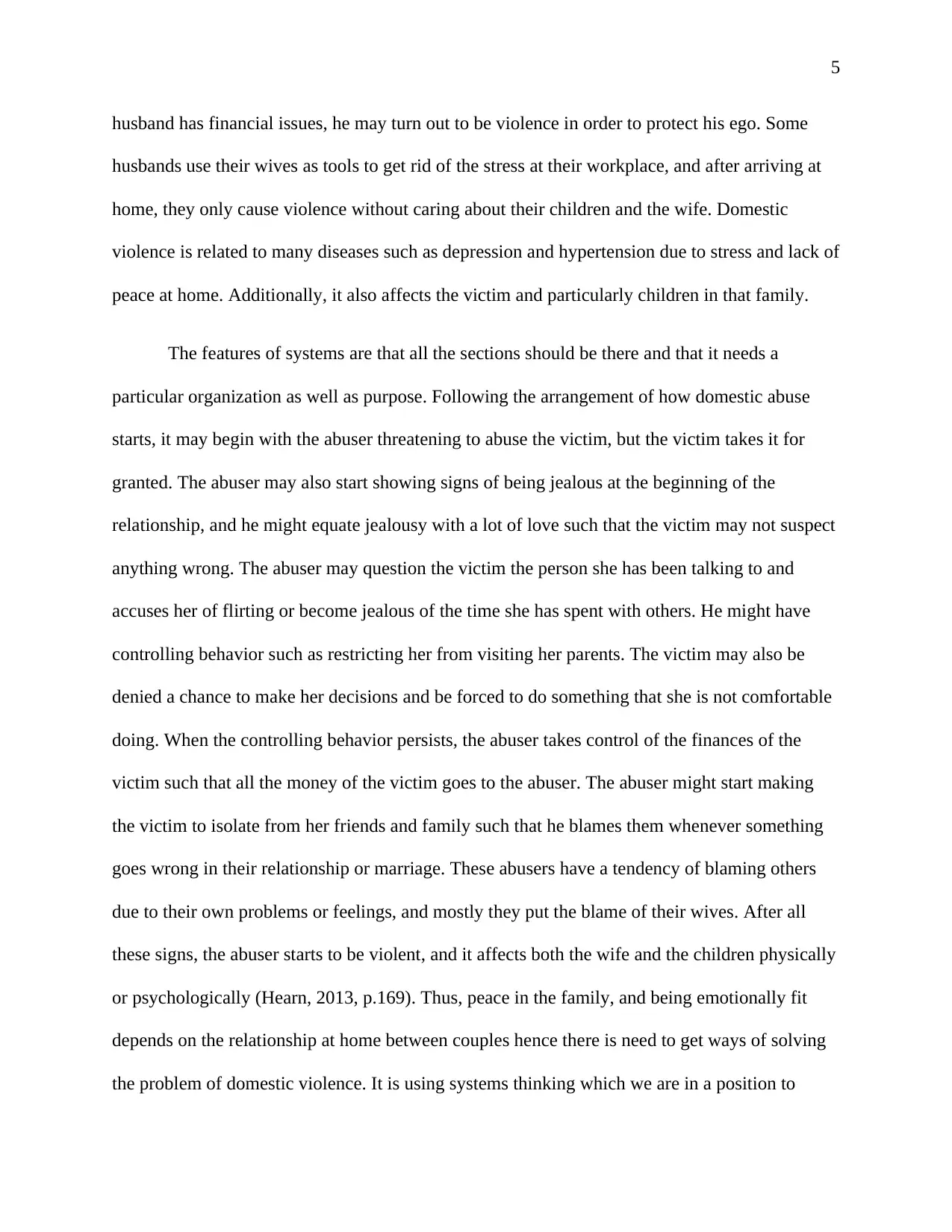
5
husband has financial issues, he may turn out to be violence in order to protect his ego. Some
husbands use their wives as tools to get rid of the stress at their workplace, and after arriving at
home, they only cause violence without caring about their children and the wife. Domestic
violence is related to many diseases such as depression and hypertension due to stress and lack of
peace at home. Additionally, it also affects the victim and particularly children in that family.
The features of systems are that all the sections should be there and that it needs a
particular organization as well as purpose. Following the arrangement of how domestic abuse
starts, it may begin with the abuser threatening to abuse the victim, but the victim takes it for
granted. The abuser may also start showing signs of being jealous at the beginning of the
relationship, and he might equate jealousy with a lot of love such that the victim may not suspect
anything wrong. The abuser may question the victim the person she has been talking to and
accuses her of flirting or become jealous of the time she has spent with others. He might have
controlling behavior such as restricting her from visiting her parents. The victim may also be
denied a chance to make her decisions and be forced to do something that she is not comfortable
doing. When the controlling behavior persists, the abuser takes control of the finances of the
victim such that all the money of the victim goes to the abuser. The abuser might start making
the victim to isolate from her friends and family such that he blames them whenever something
goes wrong in their relationship or marriage. These abusers have a tendency of blaming others
due to their own problems or feelings, and mostly they put the blame of their wives. After all
these signs, the abuser starts to be violent, and it affects both the wife and the children physically
or psychologically (Hearn, 2013, p.169). Thus, peace in the family, and being emotionally fit
depends on the relationship at home between couples hence there is need to get ways of solving
the problem of domestic violence. It is using systems thinking which we are in a position to
husband has financial issues, he may turn out to be violence in order to protect his ego. Some
husbands use their wives as tools to get rid of the stress at their workplace, and after arriving at
home, they only cause violence without caring about their children and the wife. Domestic
violence is related to many diseases such as depression and hypertension due to stress and lack of
peace at home. Additionally, it also affects the victim and particularly children in that family.
The features of systems are that all the sections should be there and that it needs a
particular organization as well as purpose. Following the arrangement of how domestic abuse
starts, it may begin with the abuser threatening to abuse the victim, but the victim takes it for
granted. The abuser may also start showing signs of being jealous at the beginning of the
relationship, and he might equate jealousy with a lot of love such that the victim may not suspect
anything wrong. The abuser may question the victim the person she has been talking to and
accuses her of flirting or become jealous of the time she has spent with others. He might have
controlling behavior such as restricting her from visiting her parents. The victim may also be
denied a chance to make her decisions and be forced to do something that she is not comfortable
doing. When the controlling behavior persists, the abuser takes control of the finances of the
victim such that all the money of the victim goes to the abuser. The abuser might start making
the victim to isolate from her friends and family such that he blames them whenever something
goes wrong in their relationship or marriage. These abusers have a tendency of blaming others
due to their own problems or feelings, and mostly they put the blame of their wives. After all
these signs, the abuser starts to be violent, and it affects both the wife and the children physically
or psychologically (Hearn, 2013, p.169). Thus, peace in the family, and being emotionally fit
depends on the relationship at home between couples hence there is need to get ways of solving
the problem of domestic violence. It is using systems thinking which we are in a position to
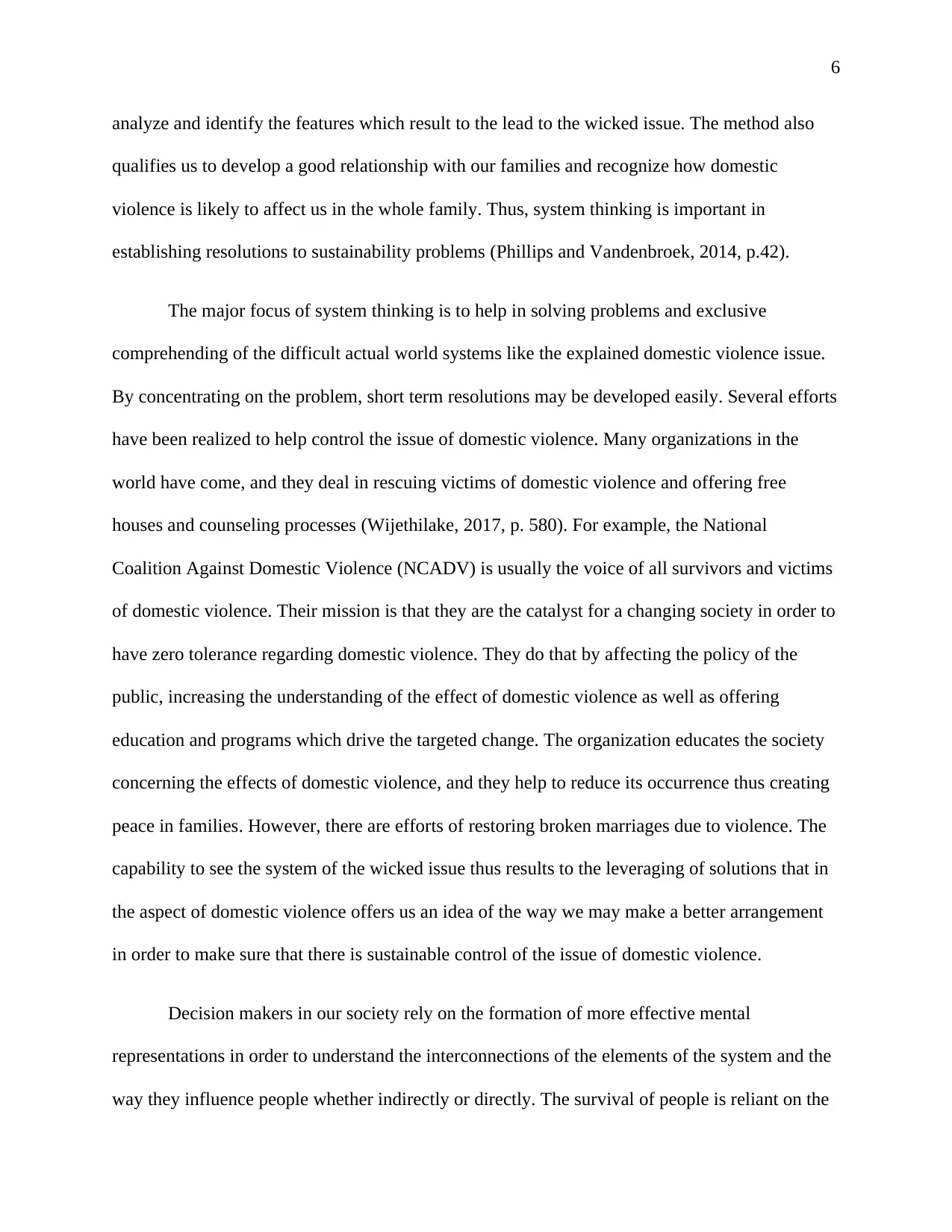
6
analyze and identify the features which result to the lead to the wicked issue. The method also
qualifies us to develop a good relationship with our families and recognize how domestic
violence is likely to affect us in the whole family. Thus, system thinking is important in
establishing resolutions to sustainability problems (Phillips and Vandenbroek, 2014, p.42).
The major focus of system thinking is to help in solving problems and exclusive
comprehending of the difficult actual world systems like the explained domestic violence issue.
By concentrating on the problem, short term resolutions may be developed easily. Several efforts
have been realized to help control the issue of domestic violence. Many organizations in the
world have come, and they deal in rescuing victims of domestic violence and offering free
houses and counseling processes (Wijethilake, 2017, p. 580). For example, the National
Coalition Against Domestic Violence (NCADV) is usually the voice of all survivors and victims
of domestic violence. Their mission is that they are the catalyst for a changing society in order to
have zero tolerance regarding domestic violence. They do that by affecting the policy of the
public, increasing the understanding of the effect of domestic violence as well as offering
education and programs which drive the targeted change. The organization educates the society
concerning the effects of domestic violence, and they help to reduce its occurrence thus creating
peace in families. However, there are efforts of restoring broken marriages due to violence. The
capability to see the system of the wicked issue thus results to the leveraging of solutions that in
the aspect of domestic violence offers us an idea of the way we may make a better arrangement
in order to make sure that there is sustainable control of the issue of domestic violence.
Decision makers in our society rely on the formation of more effective mental
representations in order to understand the interconnections of the elements of the system and the
way they influence people whether indirectly or directly. The survival of people is reliant on the
analyze and identify the features which result to the lead to the wicked issue. The method also
qualifies us to develop a good relationship with our families and recognize how domestic
violence is likely to affect us in the whole family. Thus, system thinking is important in
establishing resolutions to sustainability problems (Phillips and Vandenbroek, 2014, p.42).
The major focus of system thinking is to help in solving problems and exclusive
comprehending of the difficult actual world systems like the explained domestic violence issue.
By concentrating on the problem, short term resolutions may be developed easily. Several efforts
have been realized to help control the issue of domestic violence. Many organizations in the
world have come, and they deal in rescuing victims of domestic violence and offering free
houses and counseling processes (Wijethilake, 2017, p. 580). For example, the National
Coalition Against Domestic Violence (NCADV) is usually the voice of all survivors and victims
of domestic violence. Their mission is that they are the catalyst for a changing society in order to
have zero tolerance regarding domestic violence. They do that by affecting the policy of the
public, increasing the understanding of the effect of domestic violence as well as offering
education and programs which drive the targeted change. The organization educates the society
concerning the effects of domestic violence, and they help to reduce its occurrence thus creating
peace in families. However, there are efforts of restoring broken marriages due to violence. The
capability to see the system of the wicked issue thus results to the leveraging of solutions that in
the aspect of domestic violence offers us an idea of the way we may make a better arrangement
in order to make sure that there is sustainable control of the issue of domestic violence.
Decision makers in our society rely on the formation of more effective mental
representations in order to understand the interconnections of the elements of the system and the
way they influence people whether indirectly or directly. The survival of people is reliant on the
⊘ This is a preview!⊘
Do you want full access?
Subscribe today to unlock all pages.

Trusted by 1+ million students worldwide
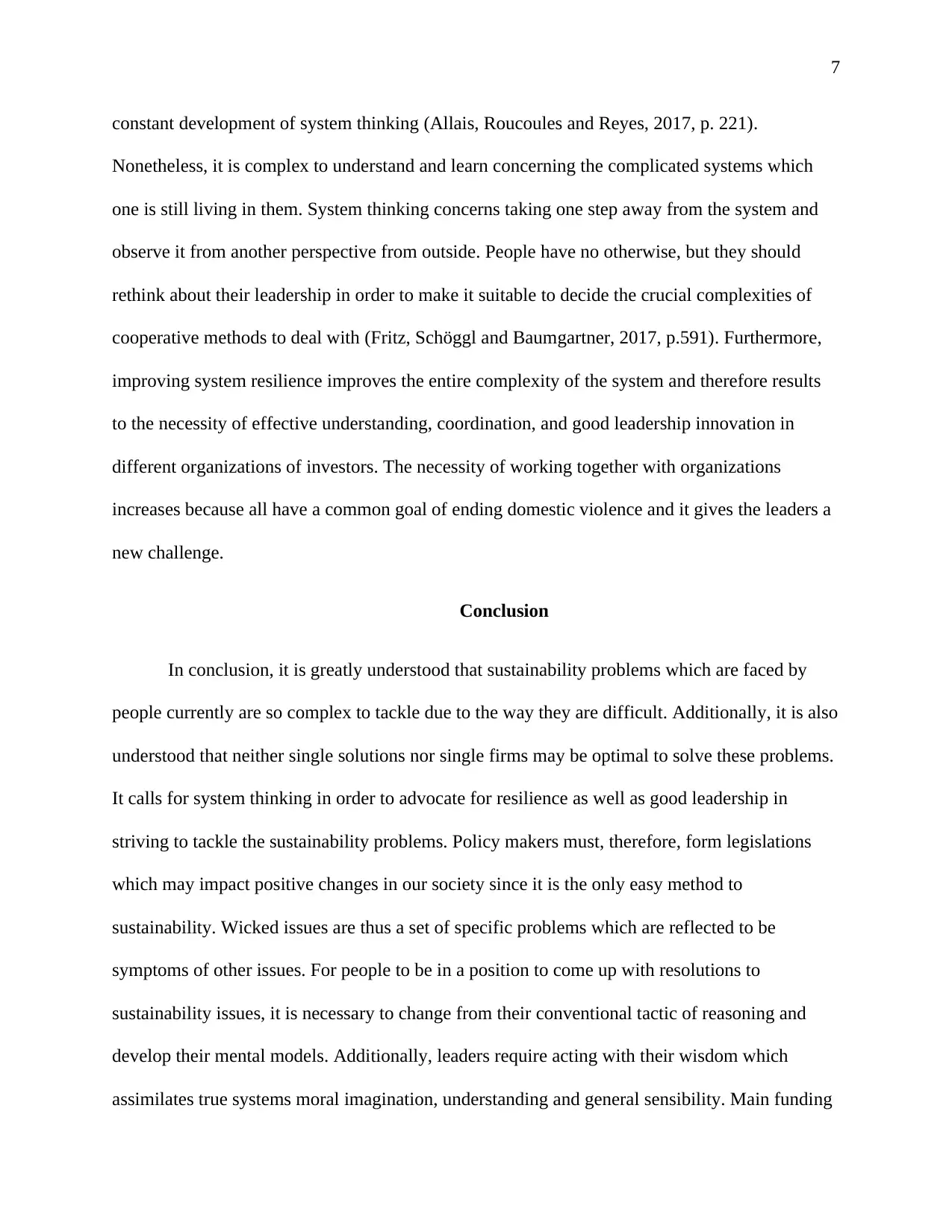
7
constant development of system thinking (Allais, Roucoules and Reyes, 2017, p. 221).
Nonetheless, it is complex to understand and learn concerning the complicated systems which
one is still living in them. System thinking concerns taking one step away from the system and
observe it from another perspective from outside. People have no otherwise, but they should
rethink about their leadership in order to make it suitable to decide the crucial complexities of
cooperative methods to deal with (Fritz, Schöggl and Baumgartner, 2017, p.591). Furthermore,
improving system resilience improves the entire complexity of the system and therefore results
to the necessity of effective understanding, coordination, and good leadership innovation in
different organizations of investors. The necessity of working together with organizations
increases because all have a common goal of ending domestic violence and it gives the leaders a
new challenge.
Conclusion
In conclusion, it is greatly understood that sustainability problems which are faced by
people currently are so complex to tackle due to the way they are difficult. Additionally, it is also
understood that neither single solutions nor single firms may be optimal to solve these problems.
It calls for system thinking in order to advocate for resilience as well as good leadership in
striving to tackle the sustainability problems. Policy makers must, therefore, form legislations
which may impact positive changes in our society since it is the only easy method to
sustainability. Wicked issues are thus a set of specific problems which are reflected to be
symptoms of other issues. For people to be in a position to come up with resolutions to
sustainability issues, it is necessary to change from their conventional tactic of reasoning and
develop their mental models. Additionally, leaders require acting with their wisdom which
assimilates true systems moral imagination, understanding and general sensibility. Main funding
constant development of system thinking (Allais, Roucoules and Reyes, 2017, p. 221).
Nonetheless, it is complex to understand and learn concerning the complicated systems which
one is still living in them. System thinking concerns taking one step away from the system and
observe it from another perspective from outside. People have no otherwise, but they should
rethink about their leadership in order to make it suitable to decide the crucial complexities of
cooperative methods to deal with (Fritz, Schöggl and Baumgartner, 2017, p.591). Furthermore,
improving system resilience improves the entire complexity of the system and therefore results
to the necessity of effective understanding, coordination, and good leadership innovation in
different organizations of investors. The necessity of working together with organizations
increases because all have a common goal of ending domestic violence and it gives the leaders a
new challenge.
Conclusion
In conclusion, it is greatly understood that sustainability problems which are faced by
people currently are so complex to tackle due to the way they are difficult. Additionally, it is also
understood that neither single solutions nor single firms may be optimal to solve these problems.
It calls for system thinking in order to advocate for resilience as well as good leadership in
striving to tackle the sustainability problems. Policy makers must, therefore, form legislations
which may impact positive changes in our society since it is the only easy method to
sustainability. Wicked issues are thus a set of specific problems which are reflected to be
symptoms of other issues. For people to be in a position to come up with resolutions to
sustainability issues, it is necessary to change from their conventional tactic of reasoning and
develop their mental models. Additionally, leaders require acting with their wisdom which
assimilates true systems moral imagination, understanding and general sensibility. Main funding
Paraphrase This Document
Need a fresh take? Get an instant paraphrase of this document with our AI Paraphraser
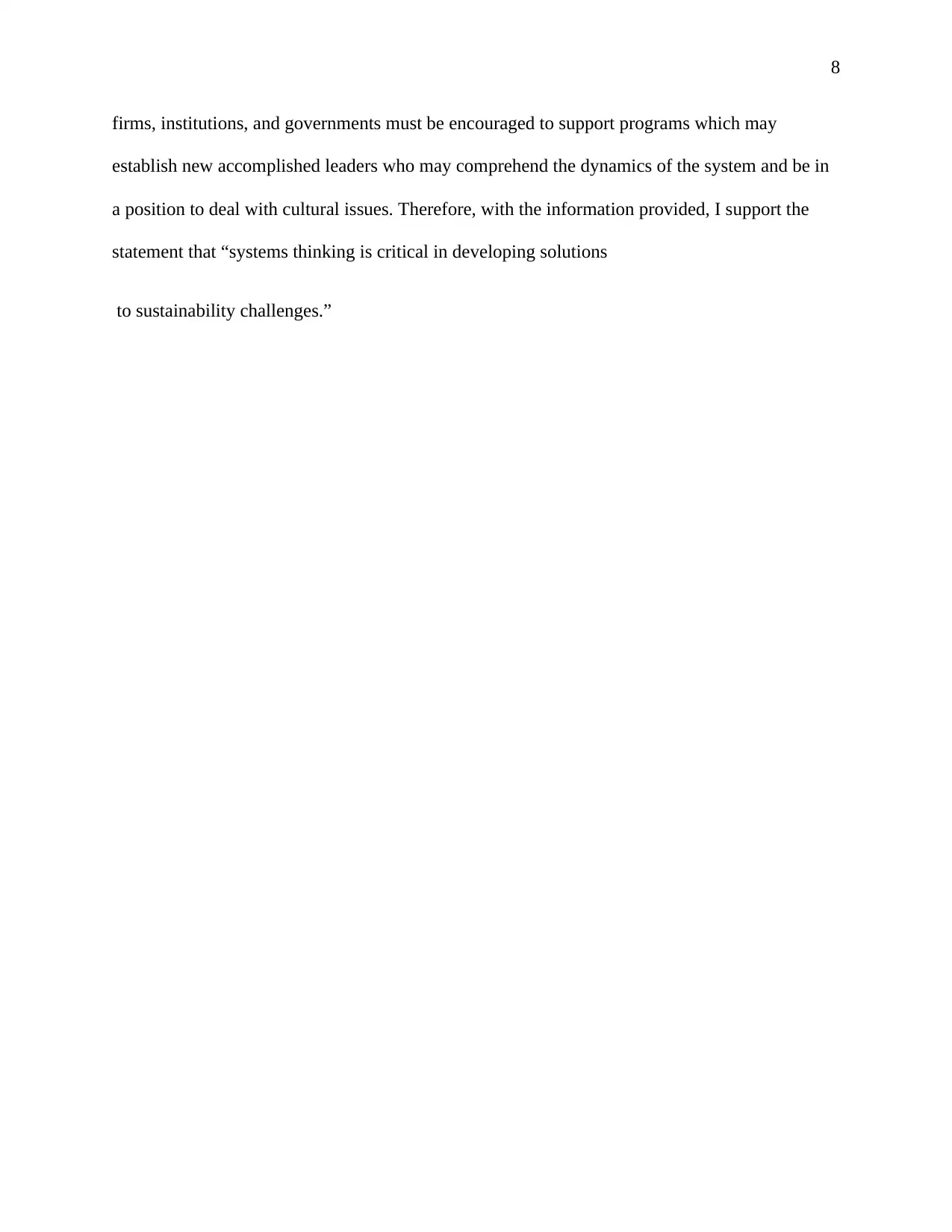
8
firms, institutions, and governments must be encouraged to support programs which may
establish new accomplished leaders who may comprehend the dynamics of the system and be in
a position to deal with cultural issues. Therefore, with the information provided, I support the
statement that “systems thinking is critical in developing solutions
to sustainability challenges.”
firms, institutions, and governments must be encouraged to support programs which may
establish new accomplished leaders who may comprehend the dynamics of the system and be in
a position to deal with cultural issues. Therefore, with the information provided, I support the
statement that “systems thinking is critical in developing solutions
to sustainability challenges.”
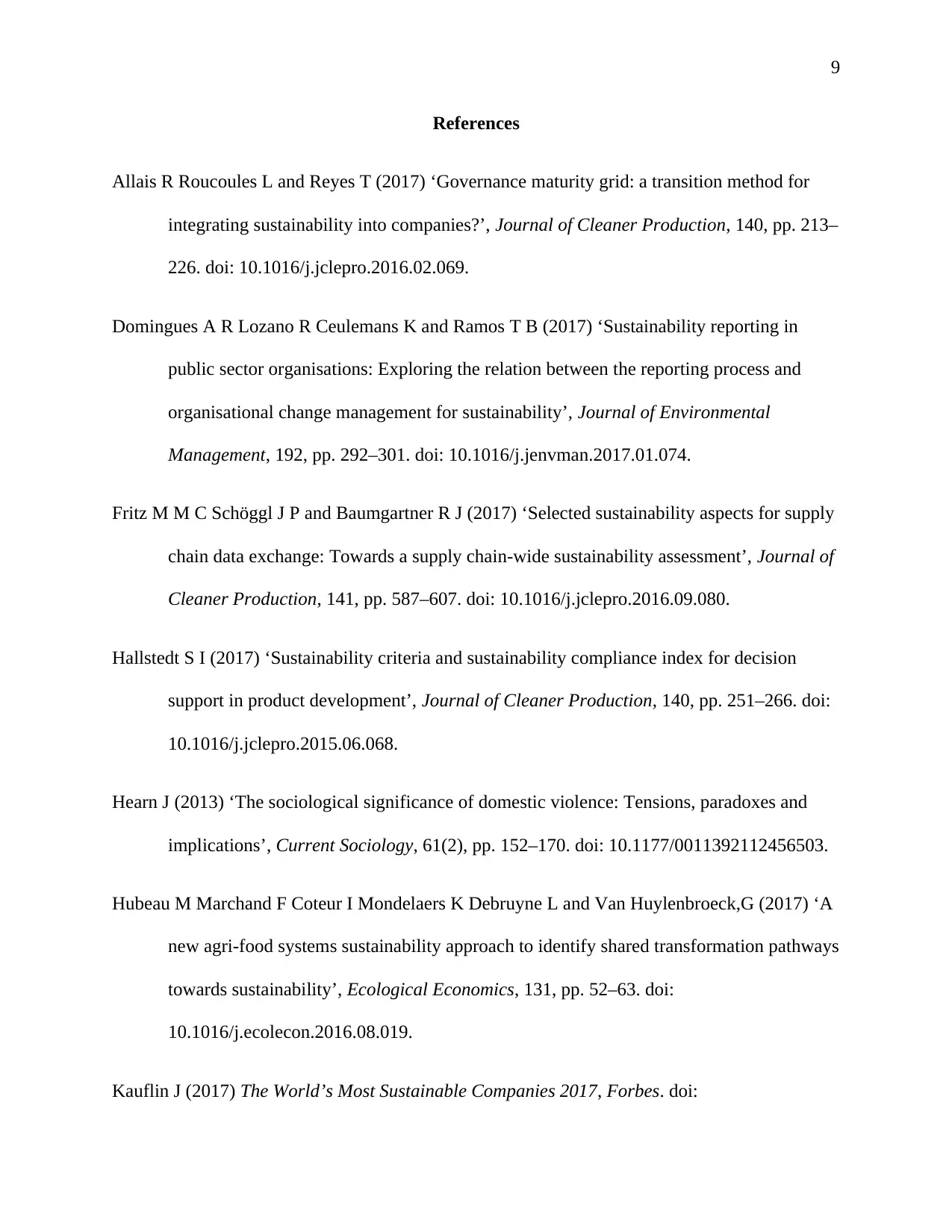
9
References
Allais R Roucoules L and Reyes T (2017) ‘Governance maturity grid: a transition method for
integrating sustainability into companies?’, Journal of Cleaner Production, 140, pp. 213–
226. doi: 10.1016/j.jclepro.2016.02.069.
Domingues A R Lozano R Ceulemans K and Ramos T B (2017) ‘Sustainability reporting in
public sector organisations: Exploring the relation between the reporting process and
organisational change management for sustainability’, Journal of Environmental
Management, 192, pp. 292–301. doi: 10.1016/j.jenvman.2017.01.074.
Fritz M M C Schöggl J P and Baumgartner R J (2017) ‘Selected sustainability aspects for supply
chain data exchange: Towards a supply chain-wide sustainability assessment’, Journal of
Cleaner Production, 141, pp. 587–607. doi: 10.1016/j.jclepro.2016.09.080.
Hallstedt S I (2017) ‘Sustainability criteria and sustainability compliance index for decision
support in product development’, Journal of Cleaner Production, 140, pp. 251–266. doi:
10.1016/j.jclepro.2015.06.068.
Hearn J (2013) ‘The sociological significance of domestic violence: Tensions, paradoxes and
implications’, Current Sociology, 61(2), pp. 152–170. doi: 10.1177/0011392112456503.
Hubeau M Marchand F Coteur I Mondelaers K Debruyne L and Van Huylenbroeck,G (2017) ‘A
new agri-food systems sustainability approach to identify shared transformation pathways
towards sustainability’, Ecological Economics, 131, pp. 52–63. doi:
10.1016/j.ecolecon.2016.08.019.
Kauflin J (2017) The World’s Most Sustainable Companies 2017, Forbes. doi:
References
Allais R Roucoules L and Reyes T (2017) ‘Governance maturity grid: a transition method for
integrating sustainability into companies?’, Journal of Cleaner Production, 140, pp. 213–
226. doi: 10.1016/j.jclepro.2016.02.069.
Domingues A R Lozano R Ceulemans K and Ramos T B (2017) ‘Sustainability reporting in
public sector organisations: Exploring the relation between the reporting process and
organisational change management for sustainability’, Journal of Environmental
Management, 192, pp. 292–301. doi: 10.1016/j.jenvman.2017.01.074.
Fritz M M C Schöggl J P and Baumgartner R J (2017) ‘Selected sustainability aspects for supply
chain data exchange: Towards a supply chain-wide sustainability assessment’, Journal of
Cleaner Production, 141, pp. 587–607. doi: 10.1016/j.jclepro.2016.09.080.
Hallstedt S I (2017) ‘Sustainability criteria and sustainability compliance index for decision
support in product development’, Journal of Cleaner Production, 140, pp. 251–266. doi:
10.1016/j.jclepro.2015.06.068.
Hearn J (2013) ‘The sociological significance of domestic violence: Tensions, paradoxes and
implications’, Current Sociology, 61(2), pp. 152–170. doi: 10.1177/0011392112456503.
Hubeau M Marchand F Coteur I Mondelaers K Debruyne L and Van Huylenbroeck,G (2017) ‘A
new agri-food systems sustainability approach to identify shared transformation pathways
towards sustainability’, Ecological Economics, 131, pp. 52–63. doi:
10.1016/j.ecolecon.2016.08.019.
Kauflin J (2017) The World’s Most Sustainable Companies 2017, Forbes. doi:
⊘ This is a preview!⊘
Do you want full access?
Subscribe today to unlock all pages.

Trusted by 1+ million students worldwide
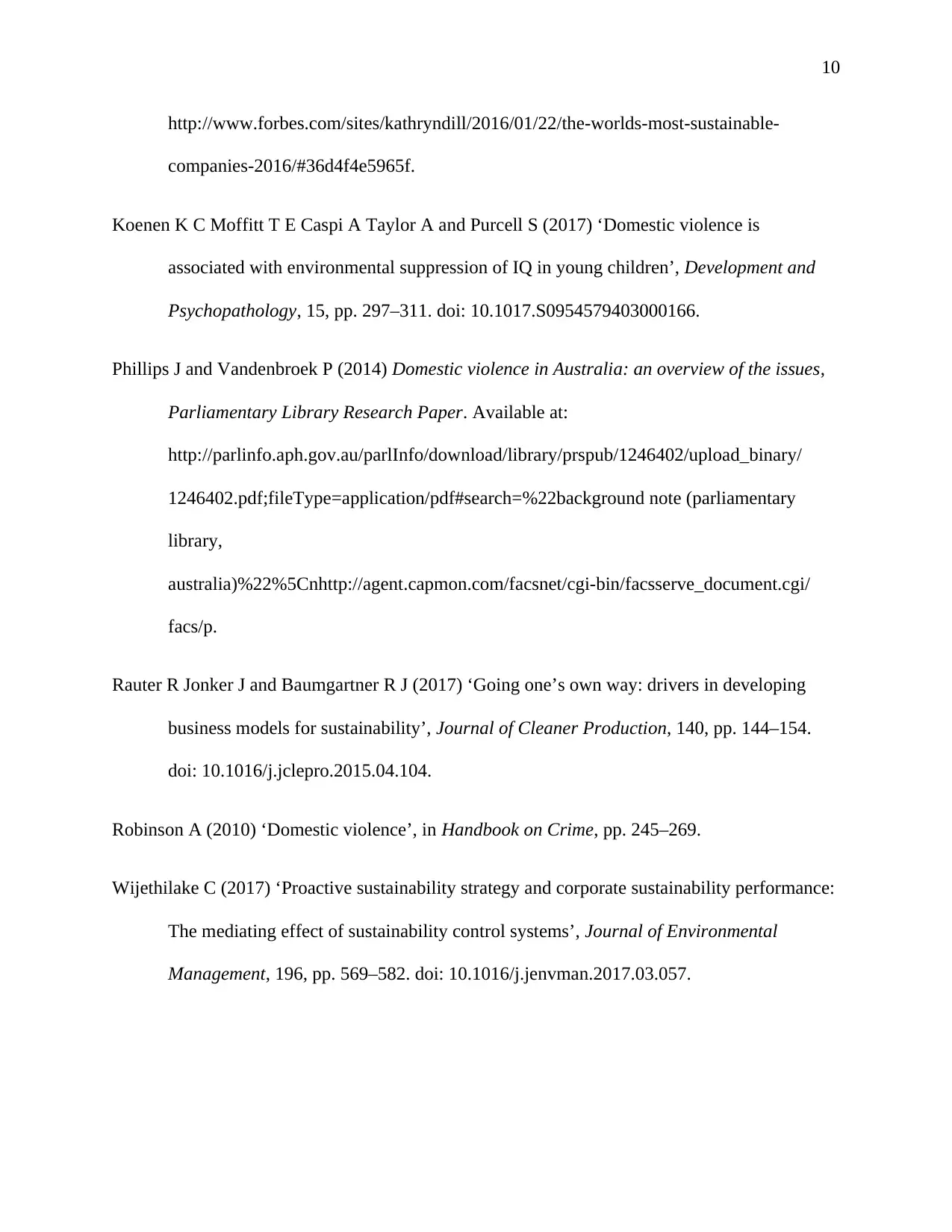
10
http://www.forbes.com/sites/kathryndill/2016/01/22/the-worlds-most-sustainable-
companies-2016/#36d4f4e5965f.
Koenen K C Moffitt T E Caspi A Taylor A and Purcell S (2017) ‘Domestic violence is
associated with environmental suppression of IQ in young children’, Development and
Psychopathology, 15, pp. 297–311. doi: 10.1017.S0954579403000166.
Phillips J and Vandenbroek P (2014) Domestic violence in Australia: an overview of the issues,
Parliamentary Library Research Paper. Available at:
http://parlinfo.aph.gov.au/parlInfo/download/library/prspub/1246402/upload_binary/
1246402.pdf;fileType=application/pdf#search=%22background note (parliamentary
library,
australia)%22%5Cnhttp://agent.capmon.com/facsnet/cgi-bin/facsserve_document.cgi/
facs/p.
Rauter R Jonker J and Baumgartner R J (2017) ‘Going one’s own way: drivers in developing
business models for sustainability’, Journal of Cleaner Production, 140, pp. 144–154.
doi: 10.1016/j.jclepro.2015.04.104.
Robinson A (2010) ‘Domestic violence’, in Handbook on Crime, pp. 245–269.
Wijethilake C (2017) ‘Proactive sustainability strategy and corporate sustainability performance:
The mediating effect of sustainability control systems’, Journal of Environmental
Management, 196, pp. 569–582. doi: 10.1016/j.jenvman.2017.03.057.
http://www.forbes.com/sites/kathryndill/2016/01/22/the-worlds-most-sustainable-
companies-2016/#36d4f4e5965f.
Koenen K C Moffitt T E Caspi A Taylor A and Purcell S (2017) ‘Domestic violence is
associated with environmental suppression of IQ in young children’, Development and
Psychopathology, 15, pp. 297–311. doi: 10.1017.S0954579403000166.
Phillips J and Vandenbroek P (2014) Domestic violence in Australia: an overview of the issues,
Parliamentary Library Research Paper. Available at:
http://parlinfo.aph.gov.au/parlInfo/download/library/prspub/1246402/upload_binary/
1246402.pdf;fileType=application/pdf#search=%22background note (parliamentary
library,
australia)%22%5Cnhttp://agent.capmon.com/facsnet/cgi-bin/facsserve_document.cgi/
facs/p.
Rauter R Jonker J and Baumgartner R J (2017) ‘Going one’s own way: drivers in developing
business models for sustainability’, Journal of Cleaner Production, 140, pp. 144–154.
doi: 10.1016/j.jclepro.2015.04.104.
Robinson A (2010) ‘Domestic violence’, in Handbook on Crime, pp. 245–269.
Wijethilake C (2017) ‘Proactive sustainability strategy and corporate sustainability performance:
The mediating effect of sustainability control systems’, Journal of Environmental
Management, 196, pp. 569–582. doi: 10.1016/j.jenvman.2017.03.057.
1 out of 10
Related Documents
Your All-in-One AI-Powered Toolkit for Academic Success.
+13062052269
info@desklib.com
Available 24*7 on WhatsApp / Email
![[object Object]](/_next/static/media/star-bottom.7253800d.svg)
Unlock your academic potential
Copyright © 2020–2025 A2Z Services. All Rights Reserved. Developed and managed by ZUCOL.




